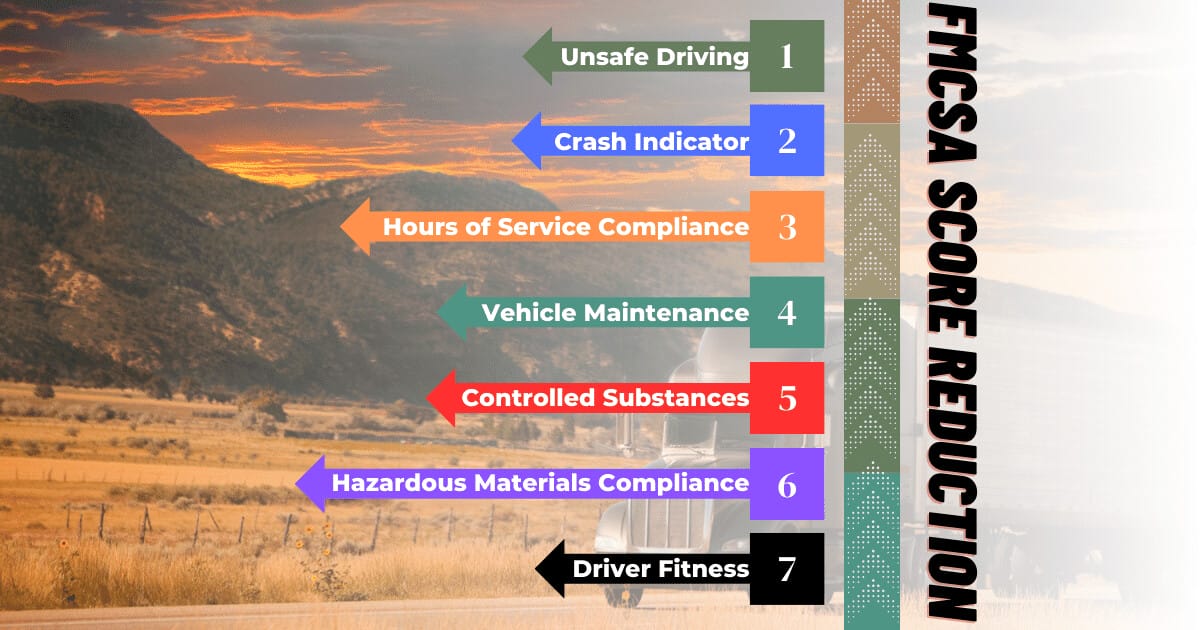FMCSA SCORE REDUCTION, HOW TO CHALLENGE FMCSA CRASH RULINGS
The Rundown:
The Compliance, Safety, Accountability (CSA) program is a familiar concept to professional drivers and trucking companies. Its primary goal is to assess drivers based on their performance and safe driving habits. The CSA program is designed to improve safety and prevent accidents on the road by holding drivers and carriers accountable for their actions.
When a driver is involved in an accident, the CSA program assigns points to them. The number of points awarded is proportional to the severity of the infraction committed. This system is designed to discourage reckless or dangerous driving habits and promote higher standards of safety on the road, as accumulating a high number of CSA points can have serious consequences.
Notably, while the points are assigned based on the driver’s actions, the score is attributed to the carrier. This means that the company employing the driver is the one that ultimately bears the responsibility for the driver’s actions. The carriers are then ranked into a percentile based on their number of CSA points. This creates a competitive environment where carriers are incentivized to ensure their drivers follow the best practices of road safety.
Each professional driver maintains a Pre-Employment Screening Program (PSP) record. This record contains information about crashes and roadside inspections that the driver has been involved in. Incidents and inspection ‘dings’ assign points to a driver, and these points are recorded in the PSP record. The PSP record serves as a comprehensive history of a driver’s performance and safety compliance, providing prospective employers with valuable information when making hiring decisions.
A driver with a high number of CSA points is generally considered a larger risk as a new hire. This is because their past performance indicates a higher likelihood of committing infractions or getting into accidents, which would negatively affect the carrier’s CSA percentile ranking. As such, carriers are often wary of hiring drivers with a high number of CSA points and will typically prefer candidates with a clean or near-clean PSP record.
Key points to remember about the CSA and PSP programs include:
- The CSA program assigns points to drivers based on the severity of their infractions.
- The points are assigned to the driver, but the score belongs to the carrier.
- Carriers are ranked into a percentile based on their CSA points.
- Each driver has a PSP record containing information about crashes and roadside inspections.
- A driver with a high number of CSA points is generally considered a larger risk as a new hire.
In conclusion, the CSA and PSP programs play a crucial role in promoting safety on the road. By holding drivers and carriers accountable for their actions, these programs encourage safer driving habits and help to prevent accidents. Prospective employers in the trucking industry can use the information provided by these programs to make informed hiring decisions and maintain a high standard of safety within their company.
Comprehensive Understanding of CSA Points and the New CPDP
CSA points, a crucial component in the trucking and transportation industry, are calculated based on seven categories. These categories include Unsafe Driving, Crash Indicator, Hours of Service (HOS) Compliance, Vehicle Maintenance, Controlled Substances/Alcohol, Hazardous Materials Compliance, and Driver Fitness. Each category plays a vital role in maintaining safety, efficiency, and compliance in the industry.
- Unsafe Driving: This category focuses on the driving behaviors of truck drivers. It includes violations such as speeding, reckless driving, improper lane change, and inattention.
- Crash Indicator: It reflects the histories of crash involvement. Prior to the recent changes, the FMCSA listed accidents on a carrier’s public safety CSA reports without stating whether the driver was at fault.
- HOS Compliance: This category measures adherence to regulations set for maximum driving time and minimum off-duty time.
- Vehicle Maintenance: This category covers the mechanical fitness of the vehicle. It includes violations related to brakes, lights, tires, and other important vehicle components.
- Controlled Substances/Alcohol: This category includes violations related to the use of drugs and alcohol, which can seriously affect a driver’s ability to operate the vehicle safely.
- Hazardous Materials Compliance: This category pertains to the safe transportation of hazardous materials.
- Driver Fitness: This category includes violations related to a driver’s health and fitness for duty, including medical conditions and driver’s licensing issues.
Previously, the FMCSA did not clarify if the accident/incident was preventable or non-preventable on the drivers PSP, which simply stated that an incident occurred. This could negatively impact drivers and carriers, as it did not represent the full context of the incident.
However, the FMCSA, upon receiving feedback from industry professionals, announced changes to the calculation process in the crash indicator category. The introduction of the new Crash Preventability Determination Program (CPDP) is a significant step forward for the industry.
Implemented on crashes that took place on or after August 5, 2019, the CPDP allows for crashes to be submitted for reconsideration. Crashes that meet certain criteria can now have their points removed and the crash results amended.
The CPDP guidelines offer several key benefits for drivers and motor carriers:
- Expansion of the types of eligible crashes: The CPDP introduces several new crash types that can now be considered for point removal.
- Modification of the Safety Measurement System: Crashes previously recorded can now be re-evaluated under the new regulations, offering a chance for points to be removed.
- Exclusion of points from crashes that were non-preventable: More types of crashes are now considered for point removal.
- Non-preventable determination noted in the PSP: Points from eligible crashes can now be reconsidered and removed, offering a more accurate representation of a driver’s safety record.
These changes will not only provide a more accurate reflection of a driver’s safety performance but will also contribute to a fairer evaluation process in the industry.
The New FMCSA CPDP Crash Types
The Federal Motor Carrier Safety Administration (FMCSA) has outlined new eligibility criteria for reconsidering crash preventability determinations. These criteria apply to crashes that occurred on or after August 5, 2019. Carriers are urged to review incidents within this timeframe and, if applicable, resubmit them for review if they fall within the categories designated by the FMCSA.
- Struck in the rear – This category applies to scenarios where a Commercial Motor Vehicle (CMV) was hit from behind or on the side at the rear. These circumstances imply that the CMV was not the cause of the collision, as the other vehicle made contact with the CMV from behind.
- Wrong Direction or Illegal Turn – This category applies when a CMV is hit by a motorist driving the wrong way, or by a vehicle making an illegal turn or U-turn. Such incidents typically indicate that the other driver was in violation of traffic laws, not the CMV driver.
- Parked legally or stopped – This category covers incidents where a CMV was hit while it was legally parked, even if unattended, or while it was obeying a traffic control device such as a stop sign, red light, or yield sign.
- Failure of the other vehicle to stop – This category applies to cases where a CMV was hit by a vehicle that failed to stop or slow down in traffic, or by a vehicle that ran a traffic control device, such as a stop sign or red light.
- Under the influence – This category is relevant when a CMV is involved in a crash where the other party was under the influence of alcohol or drugs. This suggests that the impairment of the other party was the primary cause of the accident.
- Medical issues, falling asleep, or distracted driving – This category applies to cases where a CMV was hit by an individual whose medical condition contributed to the crash (such as a heart attack or stroke while driving). It also covers incidents where the CMV was hit by a driver who admitted to falling asleep at the wheel or being distracted by a cell phone, GPS device, passengers, or other distractions.
- Cargo/Equipment/Debris or Infrastructure Failure – This category covers incidents where a CMV was hit by cargo, equipment, or debris (such as rocks, a fallen tree, or items in the road) or where failures in highway infrastructure (like a bridge collapse) led to the collision.
- Animal Strike – This category applies to cases where a CMV hits an animal, causing a crash. Here, the unpredictability of wildlife is considered the primary cause of the accident, rather than any actions or errors on the part of the CMV driver.
- Suicide – This category applies to incidents where a CMV hit an individual who was attempting to commit suicide. In these tragic circumstances, the individual’s intent to harm themselves is considered the cause of the collision, not the actions of the CMV driver.
- Rare or Unusual – This category covers incidents that do not fit into any of the other crash type categories. These could include very rare or unusual circumstances that led to the collision.
The FMCSA’s new criteria for crash preventability determinations aim to provide a fairer assessment of CMV drivers’ safety records by taking into account the wide variety of factors that can lead to crashes. This change acknowledges that not all crashes involving CMVs are the fault of the CMV driver, and provides a mechanism for those drivers to clear their records of accidents that were beyond their control.
The Best Part? FMCSA is listening.
“We’ve listened to carriers, drivers, and other commercial motor vehicle stakeholders throughout each step of this process, and strongly encourage all interested parties to submit comments on our proposed changes.”
– Raymond P. Marinez, FMCSA Administrator
The Federal Motor Carrier Safety Administration (FMCSA) is taking significant strides to improve road safety by reforming its Compliance, Safety, and Accountability (CSA) program. The FMCSA has been actively involving stakeholders in this process, indicating its commitment to collaboration and transparency. The administration’s chief, Raymond P. Martinez, has emphasized this approach, stating that they’ve been listening to carriers, drivers, and other commercial motor vehicle stakeholders throughout each step of this process.
Safety, and Accountability (CSA) program. The FMCSA has been actively involving stakeholders in this process, indicating its commitment to collaboration and transparency. The administration’s chief, Raymond P. Martinez, has emphasized this approach, stating that they’ve been listening to carriers, drivers, and other commercial motor vehicle stakeholders throughout each step of this process.
The FMCSA’s responsive approach has led to a more accurate Safety Measurement Score under the CSA program. This score is crucial as it reflects a motor carrier’s safety performance and behavior. The main improvement is that drivers will no longer bear the burden of penalties for accidents that were not their fault. This is a significant shift in policy and one that will likely be welcomed by drivers across the nation. It acknowledges that punishing drivers for accidents beyond their control is unjust and counterproductive.
The decision to amend the rule came after a recent review cycle that revealed a startling statistic. Upon examining eligible accidents, the FMCSA found that approximately 93% of crash rulings were overturned. This high rate of overturned rulings indicates that many drivers were being unfairly penalized under the previous system.
The administration has acted swiftly in response to these findings. Within 60 days of determining that a crash was non-preventable, the CSA points from such crashes were recorded and removed from the carriers’ CSA profile. This swift action demonstrates the FMCSA’s commitment to fairness and accuracy in its safety measurement system.
To summarize, the FMCSA’s progressive changes to the CSA program include:
- Actively involving stakeholders in the reform process
- Reforming the Safety Measurement Score to reflect a more accurate view of driver safety performance
- Abolishing penalties for drivers involved in accidents that were not their fault
- Promptly updating CSA profiles following the reevaluation of crash rulings
These changes reflect a shift towards a more fair and accurate system for assessing driver safety. While the FMCSA’s new approach is commendable, it’s important to continue monitoring the implementation of these reforms to ensure they effectively enhance road safety for all.
Want to challenge a crash to help with your FMCSA Score Reduction?
When it comes to challenging a crash for FMCSA score reduction as a professional driver or motor carrier, the process can be complex, but it is certainly possible. The Federal Motor Carrier Safety Administration (FMCSA) provides a platform known as the Request for Data Review (RDR) system, where crashes can be reviewed and categorized into one of eight sections. This system is part of the FMCSA’s Compliance, Safety, Accountability (CSA) initiative.
The CSA is an FMCSA initiative that was launched to improve large truck and bus safety and, consequently, reduce crashes, injuries, and fatalities related to commercial motor vehicles. If a crash is deemed non-preventable after review, it will be displayed as such on the driver’s Pre-Employment Screening Program (PSP) record and the CSA points associated with the crash will be removed from their carrier’s safety performance score, thus contributing to FMCSA score reduction.
To initiate the FMCSA score reduction process via crash review, professional drivers or motor carriers should follow these steps:
- Login to the DataQs website and submit a request for data review. This request will lead to the crash being reviewed and categorized. It’s important to note that only crashes that fall into one of the eligible, non-preventable types can be reviewed for FMCSA score reduction.
- Submit the necessary documents either by fax or by uploading them directly to the DataQs system. The documents required will depend on the nature of the crash, but generally, they include a police report and any additional evidence that supports the claim that the crash was non-preventable.
- Regularly check the status of your request on the DataQs system. The review process can take some time, but you can monitor its progress online.
- Once a final ruling has been made, you can view any changes to your SMS/PSP record directly on the DataQs system, including any FMCSA score reduction.
When submitting a request for data review for FMCSA score reduction, it’s critical to provide sufficient evidence to support your claim. This evidence might include dashcam footage, photographs of the accident scene, and any relevant court documents. The more comprehensive and compelling your evidence, the better chance you have of successfully challenging the crash and achieving FMCSA score reduction.
In addition to the evidence mentioned above, the request must contain an official police report. If the crash involved a fatality, drug and alcohol tests must have been conducted, and the results should be included in the application. If testing did not occur at the time of the accident, the applicant must submit documentation explaining the reason for the absence of these tests.
Ultimately, the goal of this process is to ensure that a driver’s PSP and their carrier’s FMCSA scores accurately reflect their safety performance. By allowing drivers and carriers to challenge crashes they believe were non-preventable, the FMCSA is working to create a more equitable and accurate system for assessing safety on our roads and facilitating FMCSA score reduction.
Keep in mind:
In the realm of trucking and commercial driving, safety and FMCSA score reduction are paramount concerns. Central to this is the DataQ system, a comprehensive online tool that allows users to challenge and rectify issues related to their Federal Motor Carrier Safety Administration (FMCSA) data. This system is invaluable for ensuring accurate data representation and can aid in FMCSA score reduction. However, it’s equally important to understand its intricacies to avoid automatic closure of requests.
Primarily, there are three key factors that the DataQ system considers when evaluating a new determination request for FMCSA score reduction:
- The Date of the Crash: Only crashes that occurred on or after August 1, 2019, are considered eligible for review under the new determination for FMCSA score reduction. This is a crucial date to remember when preparing to submit a request.
- The Category of the Crash: The crash under consideration must fit into one of the eligible categories for FMCSA score reduction. These categories are specifically defined by the FMCSA, and it’s imperative to ensure that the crash fits into one of these before proceeding with a request.
- The Correct Crash Report Number: Each crash is assigned a unique report number. Using the correct crash report number is essential to ensure that the correct incident is being evaluated for FMCSA score reduction.
These considerations are not arbitrary. They are designed to streamline the process and ensure that only relevant and eligible requests for FMCSA score reduction are evaluated. Failure to meet any of these criteria may result in the automatic closure of your request.
When it comes to the issue of CSA points assigned after non-preventable accidents, it’s important to note that the FMCSA has updated its procedures. These amendments aim to provide a more accurate reflection of a motor carrier’s safe behaviors, thereby ensuring fairness and aiding in FMCSA score reduction. If you have been assigned CSA points following an accident deemed non-preventable, it is strongly recommended that you submit the accident for reconsideration.
The FMSCA’s official release provides further insights into the changes and how they impact the trucking and commercial driving industry, including FMCSA score reduction. It’s a valuable resource for anyone seeking to understand the nuances of the system.
In conclusion, the DataQ system, while complex, is a critical tool for motor carriers and commercial drivers. Understanding its workings and requirements is the first step towards ensuring accurate data representation, fair treatment, and potential FMCSA score reduction. Whether you’re challenging CSA points or seeking a new crash determination, keep these points in mind and navigate the system with confidence.
Infinit-I’s Training Management System offers a plethora of benefits to improve ROI and assist with FMCSA score reduction.
- Improve Fuel Efficiency 3.5 -15.5%: The training provided by Infinit-I can help drivers better understand efficient driving techniques, leading to substantial fuel savings.
- Reduce CSA violations by up to 50%: Infinit-I’s system provides detailed training on compliance, helping reduce the number of CSA violations.
- Reduce Accident Costs by up to 50.7%: Through thorough safety training, Infinit-I helps lower the risk of accidents, thus reducing related costs.
- Reduce Training Costs by up to 50%: Infinit-I’s online training platform eliminates the need for physical training facilities, reducing overall costs.
- Reduce Accidents by at least 18%: Infinit-I’s safety training helps drivers avoid risky behaviors, leading to fewer accidents.
- Reduce Driver Turnover up to 85%: Infinit-I’s training system helps improve driver satisfaction, leading to lower turnover.
- Reduced Overages, Shortages, and Damages: Infinit-I’s comprehensive training can help drivers better manage cargo, reducing incidents of overages, shortages, and damages.
- Reduced Overall Office Expenses: With online training, companies can save on various office-related costs such as printing and materials.
- Access to Apple and Android apps, making training access quick and easy: Infinit-I’s training platform is accessible on both Apple and Android devices, making it easy for drivers to access training materials anytime, anywhere.
- Strengthening Legal Defense: Accident prevention training through Infinit-I can provide a solid legal defense in case of accidents. The documented training records can serve as evidence that the company took reasonable steps to ensure the safety of its drivers, potentially mitigating liability in legal proceedings.
FAQs
What are CSA points and why are they important?
CSA points are a measure of safety in the trucking and transportation industry. They are calculated based on seven categories including Unsafe Driving, Crash Indicator, Hours of Service Compliance, Vehicle Maintenance, Controlled Substances/Alcohol, Hazardous Materials Compliance, and Driver Fitness. These points are important because they reflect the safety performance of drivers and carriers.
What changes were made to the calculation of CSA points?
The FMCSA made changes to the calculation process in the crash indicator category. The new Crash Preventability Determination Program (CPDP) allows for crashes to be submitted for reconsideration, and crashes that meet certain criteria can now have their points removed and the crash results amended.
What is the importance of the new CPDP?
The CPDP provides a more accurate reflection of a driver’s safety performance and contributes to a fairer evaluation process in the industry.
What are the benefits of the CPDP guidelines?
The CPDP guidelines expand the types of eligible crashes, modify the Safety Measurement System, exclude points from crashes that were non-preventable, and note non-preventable determination in the PSP.
What new crash types have been introduced by the FMCSA CPDP?
The FMCSA has outlined new eligibility criteria for reconsidering crash preventability determinations. These include: Struck in the rear, Wrong Direction or Illegal Turn, Parked legally or stopped, Failure of the other vehicle to stop, Under the influence, Medical issues, falling asleep, or distracted driving, Cargo/Equipment/Debris or Infrastructure Failure, Animal Strike, Suicide, and Rare or Unusual.
How has the FMCSA responded to stakeholder feedback?
The FMCSA has taken significant strides to improve road safety by reforming its Compliance, Safety, and Accountability (CSA) program. This includes actively involving stakeholders in the reform process and adjusting the Safety Measurement Score to better reflect driver safety performance.
How can a safety manager challenge a crash for FMCSA score reduction?
To challenge a crash for CSA score reduction, safety managers can use the FMCSA’s Request for Data Review (RDR) system. This involves logging in to the DataQs website, submitting a request for data review, submitting the necessary documents, and regularly checking the status of the request.
What evidence is needed to challenge a crash?
When submitting a request for data review, it’s critical to provide sufficient evidence to support your claim. This evidence might include dashcam footage, photographs of the accident scene, and any relevant court documents.
What is the importance of the official police report in a request for data review?
The official police report is a critical piece of evidence in a request for data review. It provides a detailed account of the accident and can help support the claim that the crash was non-preventable.
What happens if a crash is deemed non-preventable after review?
If a crash is deemed non-preventable after review, it will be displayed as such on the driver’s Pre-Employment Screening Program (PSP) record and the CSA points associated with the crash will be removed from their carrier’s safety performance score.
What are the steps to initiate the CSA score reduction process via crash review?
To initiate the CSA score reduction process via crash review, login to the DataQs website, submit a request for data review, submit the necessary documents, and regularly check the status of your request.
What are the key considerations when using the DataQ system?
There are three key factors that the DataQ system considers when evaluating a new determination request for CSA score reduction: The Date of the Crash, The Category of the Crash, and The Correct Crash Report Number.
What is the FMCSA’s Compliance, Safety, Accountability (CSA) initiative?
The CSA is an FMCSA initiative that was launched to improve large truck and bus safety and reduce crashes, injuries, and fatalities related to commercial motor vehicles.
What is the DataQ system?
The DataQ system is a comprehensive online tool that allows users to challenge and rectify issues related to their Federal Motor Carrier Safety Administration (FMCSA) data. It’s a critical tool for motor carriers and commercial drivers.
How can safety managers ensure accurate data representation?
Safety managers can ensure accurate data representation by understanding the workings and requirements of the DataQ system and by providing comprehensive and compelling evidence when challenging crashes.
Why is it important to continue monitoring the implementation of these reforms?
It’s important to continue monitoring the implementation of these reforms to ensure they effectively enhance road safety for all.
Recent DataQ Webinars
Don’t forget these must-read articles:
HOW TO NAVIGATE THE DATAQ SYSTEM
SAFETY MANAGERS’ RELIEF; THE DRUG AND ALCOHOL CLEARINGHOUSE
















